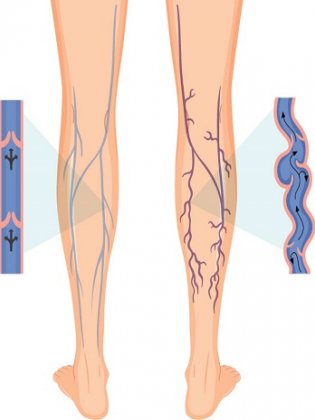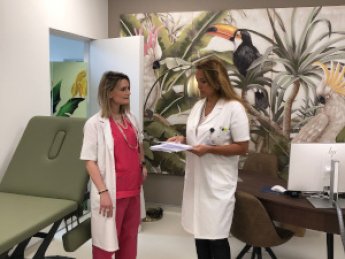Superficial venous insufficiency and varicose veins
Symptoms, Diagnosis and Treatment
The role of your leg veins is to carry blood up from your feet to a large vein in the abdomen called the inferior vena cava, which then brings the blood to the heart.
Veins have valves that prevent the blood from flowing backwards toward your feet when you are standing.
There are two sets of veins in the legs:
- Deep veins, which perform most of the work of moving blood back to your heart
- Superficial veins: the two main superficial veins are the great saphenous vein, which begins at the foot and travels up the inside of the leg, ending at the groin; and the small saphenous vein, which also begins at the foot and travels up the back of the calf, ending at the popliteal fossa (at the back of the knee).
What are venous insufficiency and varicose veins?
Venous insufficiency is a very common disorder that affects 20 to 30 percent of the population, predominantly women. Other risk factors include family history, being overweight, age, multiple pregnancies and having a job that requires standing for long periods.
Venous insufficiency may be caused by:
- Deep veins malfunction: this is usually a sequela of thrombosis (or phlebitis) which damages the valves of the deep veins.
- More frequently, by valve malfunction in the superficial veins: this is called superficial venous insufficiency, and may cause a saphenous vein or one of its branches to become a varicose vein.
What are the symptoms of venous insufficiency?
The most common symptoms of venous insufficiency are a feeling of heaviness in the legs and swelling around the ankles at the end of the day. These symptoms are made worse by heat and long periods of standing or sitting.
Over time, the skin on the legs and ankles may acquire a leathery appearance, or eczema or ulcers may form.
Sometimes, small veins become permanently dilated. This may lead to spider veins, which are small clusters of reddish or purplish vessels that are unattractive but not harmful to your health. Dilation may also affect the saphenous veins or its branches, causing them to bulge and twist. This is known as varicose veins.
The most common complaints about spider and varicose veins are their symptoms and unattractive appearance.

What treatments are available for venous insufficiency and varicose veins?
Many medical solutions are currently available to relieve the symptoms of venous insufficiency.
Various treatments also exist to remove unattractive superficial veins, depending on their size:
- For spider veins and smaller varicose veins: foam or liquid sclerotherapy, as long as there are abnormalities affecting the major veins
- For saphenous vein insufficiency:
- Destruction via endovenous thermal ablation
- Removal through surgical vein stripping and/or phlebectomy
- Preservation by restructuring the venous pathways: strategic points, identified prior to the procedure via Doppler ultrasound, are tied off (CHIVA technique).
At the American Hospital of Paris, we practice the full range of modern-day techniques to explore and treat spider and varicose veins. All methods are minimally invasive and performed on an outpatient basis.
Whether you are seeking relief for your legs or wish to discuss your options for the removal of varicose veins, you will need to see a doctor specialized in vascular medicine or surgery. After this initial visit, you will undergo a venous Doppler ultrasound to obtain a precise “map” of your legs veins. This will be used to identify the mechanism causing your venous insufficiency and determine the most appropriate treatment method.
Make an appointment with our vascular medicine team
Learn moreMake an appointment with our vascular surgery team
Learn more

